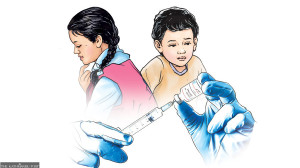Arts
At Windhorse Gallery, it’s not horses but mules and donkeys who steal the show
In Nepali culture to be called a donkey or a mule is taken as an offence. But Bharat Rai through his paintings subvert our preconceived biases making us empathise with the creatures instead.
Ankit Khadgi
When one enters Windhorse Gallery, located at Bhanimandal, Lalitpur, they are bound to be bewildered by the paintings that adorn the walls.
Almost every painting depicts donkeys and mules hopping, lifting one another, sitting and standing in glory, and showing their strength and resilience. In a society where donkeys and mules are considered stubborn and foolish, and being called a donkey or a mule is taken as an offence, we rarely get to see the animals portrayed in such a positive light.
Bharat Rai, the artist behind the paintings, says he wanted his works to focus on the strength of the animals.
“As an artist, I wanted to portray donkeys and mules as strong animals and to show people that they aren’t foolish and unintelligent like how we perceive them. They are animals with strength whose capabilities know no bounds,” says Rai, who’s exhibiting his works for the first time in a solo exhibition at Windhorse Gallery.
Titled ‘Whistle Blower’, the exhibition features 35 artworks of Rai, who has mainly used the medium of paintings for the exhibition.
Two paintings greet the visitors just next to the stairs that visitors have to climb to reach the gallery. Titled ‘Punte’ and ‘Bhunte’, both paintings are strikingly similar; there is an image of a donkey with its nostrils flaring in pride and looking at the onlookers. While the painting isn’t extraordinary, it sets the exhibition's mood. We are given a hint from the very beginning of what to expect from Rai’s artworks.
As we climb the stairs, we are greeted by three enormous paintings of mules. Through the sheer size of the mules, Rai succeeds in depicting the animal’s strength. But what makes his paintings impactful are the motifs.
For instance, in ‘Khambe’, one of the paintings among the three big ones kept above the staircase, we can see a brown mule leaping and lifting a younger mule. Also on the backs of the brown mule are two heavy trucks. The mule’s face doesn’t have an iota of tiredness despite the load.
Besides the three gigantic artworks, other equally evocative paintings deliver a similar message in the gallery space. But it is ‘Hero’, a painting crafted with great finesse, that leaves an everlasting impression because the artwork perfectly encapsulates the exhibition's theme and shows the creator's talent and skills.
'Hero' features a mule hopping on a plinth. Its forehead is covered in jewels, making it seem almost heroic and god-like.
“Generally in our society, we associate traits of strength and bravery with horses. But as someone who grew up living and interacting with mules and donkeys like a friend, I have seen their resilience and endurance,” says Rai, a native of Solukhumbu. “They are equally brave. It’s actually us who have failed to see their strength.”
In many of Nepal’s geographically remote mountainous regions, where motorable roads don’t exist, villagers rely on donkeys and mules to transport everything from rice, gas cylinders, wood to construction materials.
By respecting donkeys and mules, Rai’s paintings are an attempt to break the conventional traits we often associate with the two animals.
In none of Rai’s paintings are the animals looked down upon or pitied. They are shown as dignified and playful animals.
In one of his paintings titled ‘Kale and Gore’, two mules—a white and a black-coloured mule—are flying in the plain white canvas, which might symbolise the sky. With no sign of human existence in the painting, the animals appear to be free and happily living just by themselves. With this powerful juxtaposition, Rai makes us realise how much humanity has taken from these animals.
But there's more to his artworks than what meets our eyes. On the surface, his paintings might be about donkeys and mules, but they also represent the experiences of marginalised communities, who, like the animals, have been pushed to the fringes of society.
“In the same way we refuse to see the hardships faced by donkeys and mules, our society has chosen to ignore the challenges faced by marginalised communities. People take advantage of the naiveness of the members of marginalised communities and treat them the way humans treat donkeys and mules,” Rai told the Post.
By subverting our preconceived notions about these animals, Rai’s artworks evoke a sense of empathy for the animals and make viewers think about how some communities are discriminated against, abused, and exploited like donkeys and mules.
The only difference is that people can speak and share their grief in words but the creatures can’t. But the pain is somehow the same, which Rai attempts to make us understand through his excellent display of works.
Unlike the artworks, the curation of the exhibition is ordinary, lacks depth, and makes it evident that not much thought has gone into it. Not much has been done other than just arranging the placement of the paintings and hanging them on the white walls.
If Rai, who also curated the exhibition, had gone the extra mile and used a few physical objects or even soundscapes related to the theme of the artworks, the exhibition would have been more immersive.
But because of his thought-provoking artworks that are powerful enough to challenge our rigid beliefs, his show will definitely leave an impression on the viewers.




 16.12°C Kathmandu
16.12°C Kathmandu
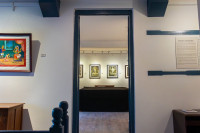
%20(1).jpg&w=200&height=120)
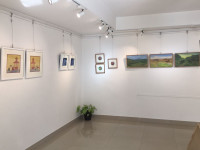
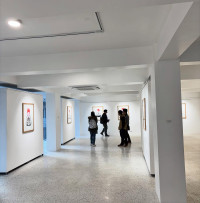
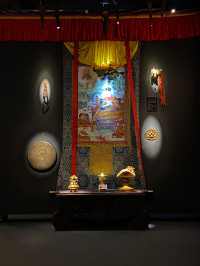
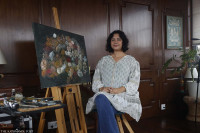


%20(1).jpg&w=300&height=200)

